9702_s08_ms_2


UNIVERSITY OF CAMBRIDGE INTERNATIONAL EXAMINATIONS
GCE Advanced Subsidiary Level and GCE Advanced Level
MARK SCHEME for the May/June 2008 question paper
9702 PHYSICS
9702/02
Paper 2 (AS Structured Questions), maximum raw mark 60
This mark scheme is published as an aid to teachers and candidates, to indicate the requirements of the examination. It shows the basis on which Examiners were instructed to award marks. It does not indicate the details of the discussions that took place at an Examiners’ meeting before marking began.
A l l Examiners are instructed that a l
ternative correct answers and unexpected approaches in candidates’ scripts must be given marks that fair l y ref l ect the re l evant know l edge and ski l l
s demonstrated.
Mark schemes must be read in conjunction with the question papers and the report on the examination.
? CIE will not enter into discussions or correspondence in connection with these mark schemes.
CIE is publ ishing the mark schemes for the May/June 2008 question papers for most IGCSE, GCE Advanced Level and Advanced Subsidiary Level syllabuses and some Ordinary Level syllabuses.
1 (a) allow anything in range 20 Hz → 20 kHz B1 [1]
(b)allow anything in range 10 nm → 400 nm B1 [1]
allow anything in range 10 g → 100 g B1 [1]
(c)
allow anything in range 0.1 kg m–3→ 10 kg m–3 B1
(d)
[1]
2 (a) (i)k is the reciprocal of the gradient of the graph C1
k = {32 / (4 × 10–2) = } 800 N m–1 A1
[2]
either energy = average force × extension or ?kx2
(ii)
or area under graph line C1
energy = ? × 800 × (3.5 × 10–2)2or ? × 28 × 3.5 × 10–2 M1
energy = 0.49 J A0 [2]
(i)momentum before cutting thread = momentum after C1
(b)
0 = 2400 × V – 800 × v M1
v / V = 3.0 A0 [2]
energy stored in spring = kinetic energy of trolleys C1
(ii)
1v)2 + ? × 0.8 × v2 C1
0.49 = ? × 2.4 × (
3
[3]
v = 0.96 m s–1 A1
(if only one trolley considered, or masses combined, allow max 1 mark)
3 (a) (i) v2 = 2as
1.22 = 2 × a × 1.9 M1
a = 0.38 m s–2 A1
[2] (ii)
F = ma
= 42 × 0.38 M1
= 16 N A0 [1]
power = Fv C1 (b)
= 16 × 1.2
= 19 W A1 [2]
(i)component = 42 × 9.8 × sin2.8 C1
(c)
= 20.1 N A1 [2]
accelerating force = 20.1 – 16 = 4.1 N C1
(ii)
acceleration of trolley = 4.1 / 42 = 0.098 m s–2 C1
s = ?at2
3.5 = ? × 0.098 × t2 C1
t = 8.5 s A1 [4]
(d)
either allows plenty of time to stop runaway trolley
or speed of trolley increases gradually
or trolley will travel faster B1 [1]
(answer must be unambiguous when read in conjunction with question)
4 (a) (i) 1.stress = force / (cross-sectional) area B1 [1]
2.strain = extension / original length B1 [1]
3.Young modulus = stress / strain B1 [1]
(ratios must be clear in each answer)
either fluids cannot be deformed in one direction / cannot be stretched
(ii)
or fluids can only have volume change
or no fixed shape B1 [1]
either unless
?p is very large or 2.2 × 109 is a large number M1
(b)
?V is very small or?V/V is very small, (so ‘incompressible’) A1 [2]
?p = hρg
(c)
×
105 = h × 1.08 × 103 × 9.81 C1
1.01
h = 9.53 m C1
?h / h = 0.47 / 10 or 0.47 / 9.53
error = 4.7% or 4.9% or 5% A1 [3]
5 (a) (i)frequency: number of oscillations per unit time M1
of the source / of a point on the wave A1 [2]
speed: speed at which energy is transferred / speed of wavefront B1
(ii)
[1]
(b)
(i)does not transfer energy (along the wave) B1 [1]
position (along wave) where amplitude of vibration is a maximum B1 [1]
(ii)
(iii)
all three positions marked B1 [1]
wavelength = 2 × 17.8 = 35.6 cm C1
(c)
v = fλC1
v= 125 × 0.356
= 44.5 m s–1 C1 44.52 = 4.00 / m C1
m = 2.0 × 10–3 kg m–1 A1
[5]
6 (a) either P = V I and V = I R or P = V 2 / R C1 resistance = 38.4 ? A1 [2]
(b) zero B1 1.5 kW B1 3.0 kW B1 0.75 kW B1 2.25 kW B1 [5]
7 (a) α-particle: either helium nucleus or contains 2 protons + 2 neutrons or He 42
B1 β-particle: either electron or e 01? B1 α speed < β speed (1) α discrete values of speed/energy, β continuous spectrum (1) either α ionising power >> β ionising power or α range << β range (1) α positive, β negative (only if first two B marks not scored) (1) α mass > β mass (only if first two B marks not scored) (1) (any two sensible pairs of statements relevant to differences, – do not allow statements relevant to only α or β, 1 each, max 2) B2 [4]
(b) (i) U 23692 → Th 232
90 M1
+ He 4
2 A1
[2]
(ii) 1. correct position for U at Z = 92, N = 145 B1 2. correct position for Np relative to U i.e. Z + 1 and N – 1 B1 [2]
